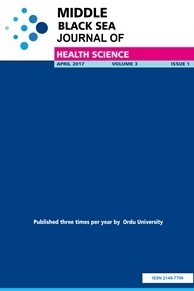Expression pattern and subcellular localization of p62/SQSTM 1 during mouse oocyte maturation
Autophagy, oocyte maturation, p62, SQSTM
Expression pattern and subcellular localization of p62/SQSTM 1 during mouse oocyte maturation
Autophagy, oocyte maturation, p62, SQSTM,
___
- 1. Filomeni G, De Zio D, Cecconi F. Oxidative stress and autophagy: the clash between damage and metabolic needs. Cell Death Differ. 2015;22(3):377-88.
- 2. Kim KH, Lee MS. Autophagy--a key player in cellular and body metabolism. Nat Rev Endocrinol. 2014;10(6):322-37.
- 3. Bhardwaj JK, Paliwal A, Saraf P, Sachdeva SN. Role of autophagy in follicular development and maintenance of primordial follicular pool in the ovary. J Cell Physiol. 2022;237(2):1157-70.
- 4. Katsuragi Y, Ichimura Y, Komatsu M. p62/SQSTM1 functions as a signaling hub and an autophagy adaptor. Febs j. 2015;282(24):4672-8.
- 5. Pankiv S, Clausen TH, Lamark T, Brech A, Bruun JA, Outzen H, et al. p62/SQSTM1 binds directly to Atg8/LC3 to facilitate degradation of ubiquitinated protein aggregates by autophagy. J Biol Chem. 2007;282(33):24131-45.
- 6. Liu WJ, Ye L, Huang WF, Guo LJ, Xu ZG, Wu HL, et al. p62 links the autophagy pathway and the ubiqutin-proteasome system upon ubiquitinated protein degradation. Cell Mol Biol Lett. 2016;21:29.
- 7. Yoshinobu I, Waguri S., Sou Y. et all Phosphorylation of p62 Activates the Keap1-Nrf2 Pathway during Selective Autophagy. Molecular Cell 2013.
- 8. Zhihan T, Xinyi M, Qingying L, Rufei G, Yan Z, Xuemei C, et al. Autophagy participates in cyst breakdown and primordial folliculogenesis by reducing reactive oxygen species levels in perinatal mouse ovaries. J Cell Physiol. 2019;234(5):6125-35.
- 9. Komatsu M, Kurokawa H, Waguri S, Taguchi K, Kobayashi A, Ichimura Y, et al. The selective autophagy substrate p62 activates the stress responsive transcription factor Nrf2 through inactivation of Keap1. Nat Cell Biol. 2010;12(3):213-23.
- 10. Ichimura Y, Waguri S, Sou YS, Kageyama S, Hasegawa J, Ishimura R, et al. Phosphorylation of p62 activates the Keap1-Nrf2 pathway during selective autophagy. Mol Cell. 2013;51(5):618-31.
- 11. Jiang T, Harder B, Rojo de la Vega M, Wong PK, Chapman E, Zhang DD. p62 links autophagy and Nrf2 signaling. Free Radic Biol Med. 2015;88(Pt B):199-204.
- 12. Rimon-Dahari N, Yerushalmi-Heinemann L, Alyagor L, Dekel N. Ovarian Folliculogenesis. Results Probl Cell Differ. 2016;58:167-90.
- 13. Filatov M, Khramova Y, Semenova M. Molecular Mechanisms of Prophase I Meiotic Arrest Maintenance and Meiotic Resumption in Mammalian Oocytes. Reprod Sci. 2019;26(11):1519-37.
- 14. Li J, Qian WP, Sun QY. Cyclins regulating oocyte meiotic cell cycle progression†. Biol Reprod. 2019;101(5):878-81.
- 15. Kala M, Shaikh MV, Nivsarkar M. Equilibrium between anti-oxidants and reactive oxygen species: a requisite for oocyte development and maturation. Reprod Med Biol. 2017;16(1):28-35.
- 16. Gao Q. Oxidative Stress and Autophagy. Adv Exp Med Biol. 2019;1206:179-98.
- 17. Xu J, Zhang D, Ju S, Sun L, Zhang S, Wu C, et al. Mitophagy is involved in the mitochondrial dysfunction of vitrified porcine oocytes. Mol Reprod Dev. 2021;88(6):427-36.
- 18. He M, Zhang T, Zhu Z, Qin S, Wang H, Zhao L, et al. LSD1 contributes to programmed oocyte death by regulating the transcription of autophagy adaptor SQSTM1/p62. Aging Cell. 2020;19(3):e13102.
- 19. Lin FH, Zhang WL, Li H, Tian XD, Zhang J, Li X, et al. Role of autophagy in modulating post-maturation aging of mouse oocytes. Cell Death Dis. 2018;9(3):308.
- 20. Uyar A, Torrealday S, Seli E. Cumulus and granulosa cell markers of oocyte and embryo quality. Fertil Steril. 2013;99(4):979-97.
- 21. He H, Wang J, Mou X, Liu X, Li Q, Zhong M, et al. Selective autophagic degradation of ACLY (ATP citrate lyase) maintains citrate homeostasis and promotes oocyte maturation. Autophagy. 2022:1-17.
- 22. Ye X, Sloboda RD. Molecular characterization of p62, a mitotic apparatus protein required for mitotic progression. J Biol Chem. 1997;272(6):3606-14.
- 23. Yun HR, Jo YH, Kim J, Shin Y, Kim SS, Choi TG. Roles of Autophagy in Oxidative Stress. Int J Mol Sci. 2020;21(9).
- 24. Agarwal A, Gupta S, Sharma RK. Role of oxidative stress in female reproduction. Reprod Biol Endocrinol. 2005;3:28.
- Yayın Aralığı: Yılda 4 Sayı
- Başlangıç: 2015
- Yayıncı: Ordu Üniversitesi
Vildan ÇAKIR KARDEŞ, Ali Deniz ÇÖLGEÇEN, Hande ÇETİN, Selin ÖNDER, Bensu Şengül ÇIRAK, Sudenur TENK, Murtaza Zülfikar KICIMAN, Büşra KART, Sait ÖZTÜRK, Durmuş Ali TAP, Yusuf Aşır AKBABA, Abdul Rahman ALFARİS, Ahmad ABU HAMED, İslam ALHASAN
Gülten CAN SEZGİN, Nilay ILDİZ
Zeynep KOLOREN, Ömer ERTÜRK, Zülal ATLI ŞEKEROĞLU, Ülkü KARAMAN
Effectıveness of Curcumın on Tracheal Anastomosıs Created in the Rat Model
Muhammed Gazi YILDIZ, Emine KILINÇ, Nida YALÇIN, Dogan ÇAKAN, İsrafil ORHAN, İrfan KARA, Atila YOLDAŞ, Adem DOĞANER
The Evolution of Hypothalamus Publications with Bibliometric Analysis During 1980-2020
Weight Drop Models in Traumatic Brain Injury
Investigation of Senior Nursing Students' Views on Internship Program
Nülüfer ERBİL, Hanife DURGUN, Yasemin KALKAN UĞURLU, Figen BAYKAL TOP, Özgül BOSTAN, Nurgül BÖLÜKBAŞ, Aslıhan ÇATIKER, Hacer GÖK UĞUR, Nevin GÜNAYDIN, Azize Nuran KAHRAMAN, Ebru ŞAHİN
